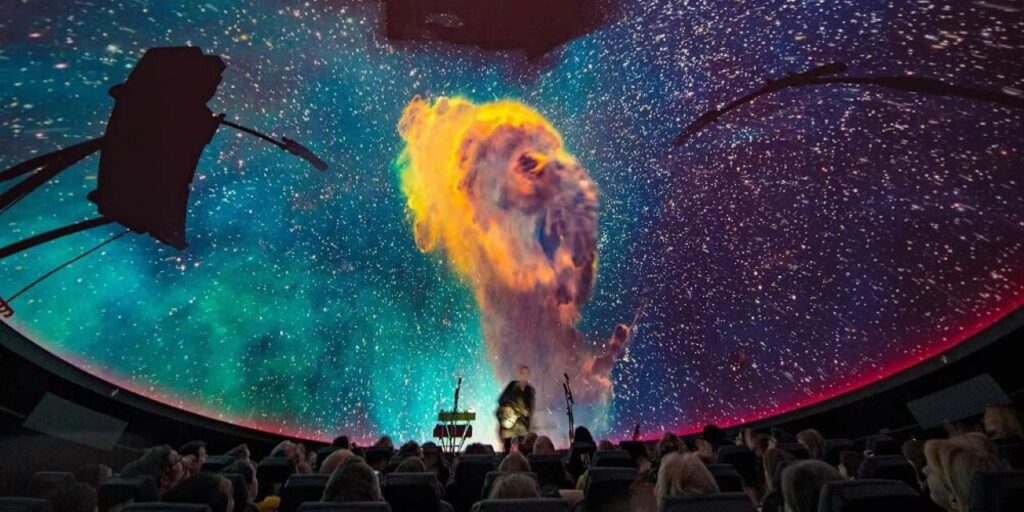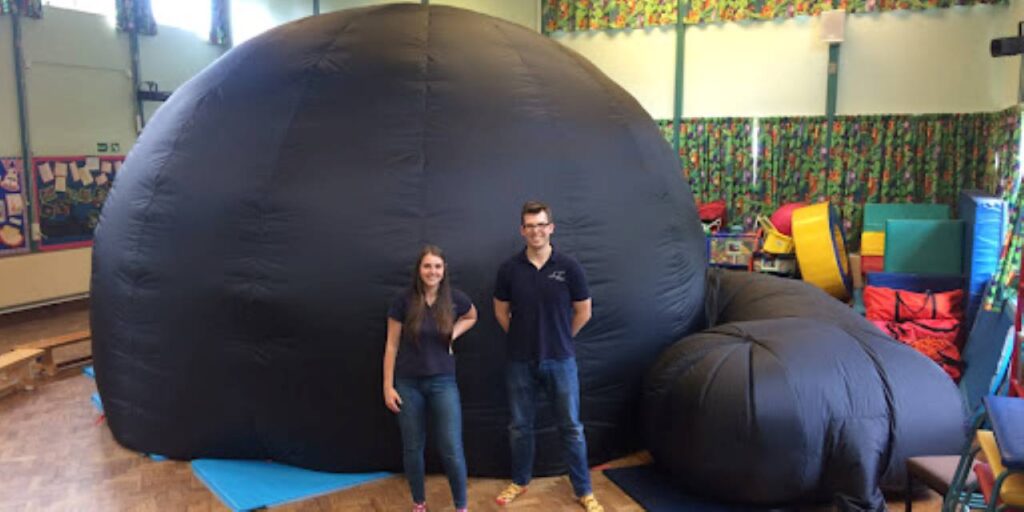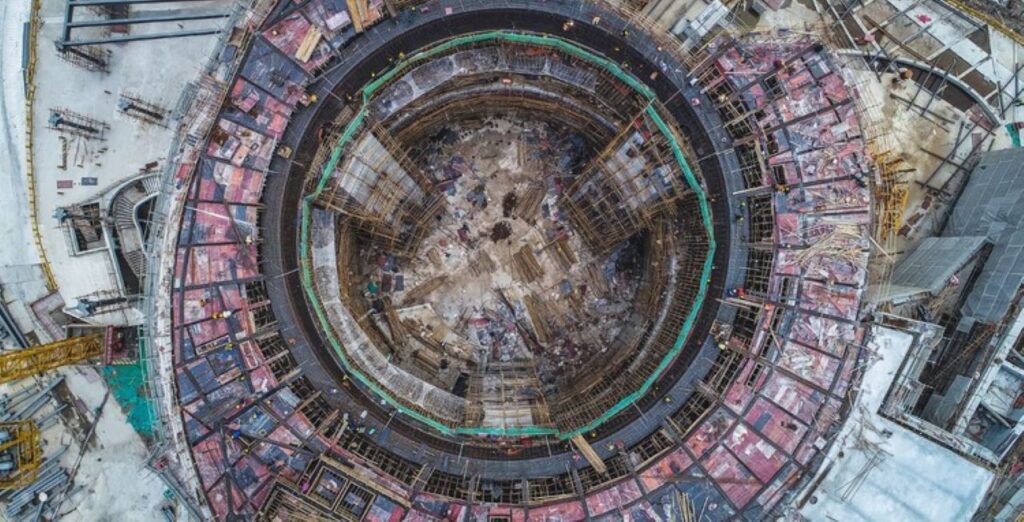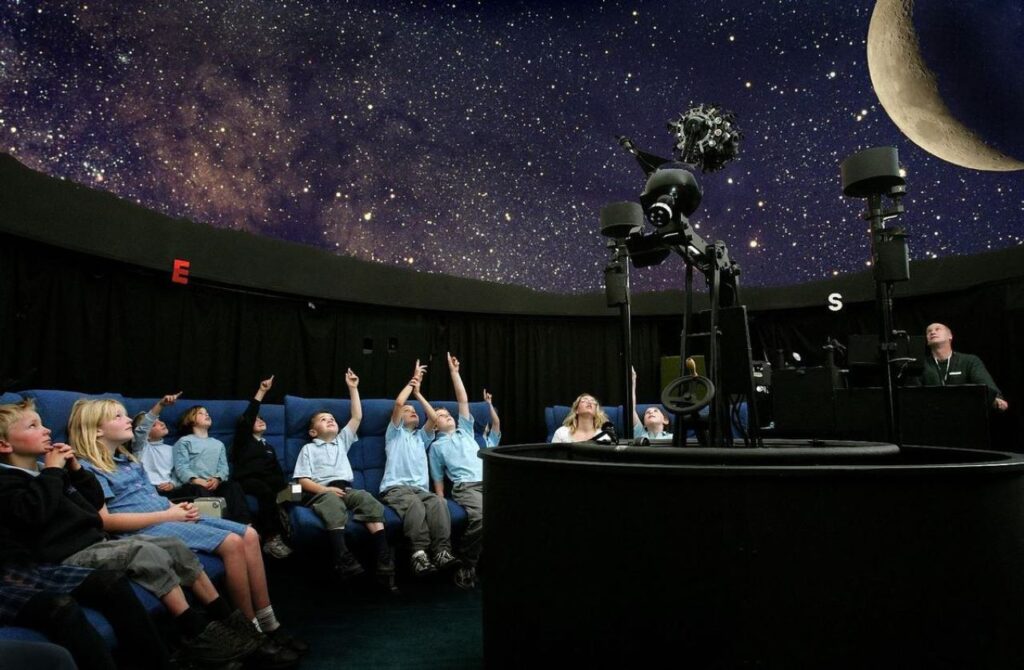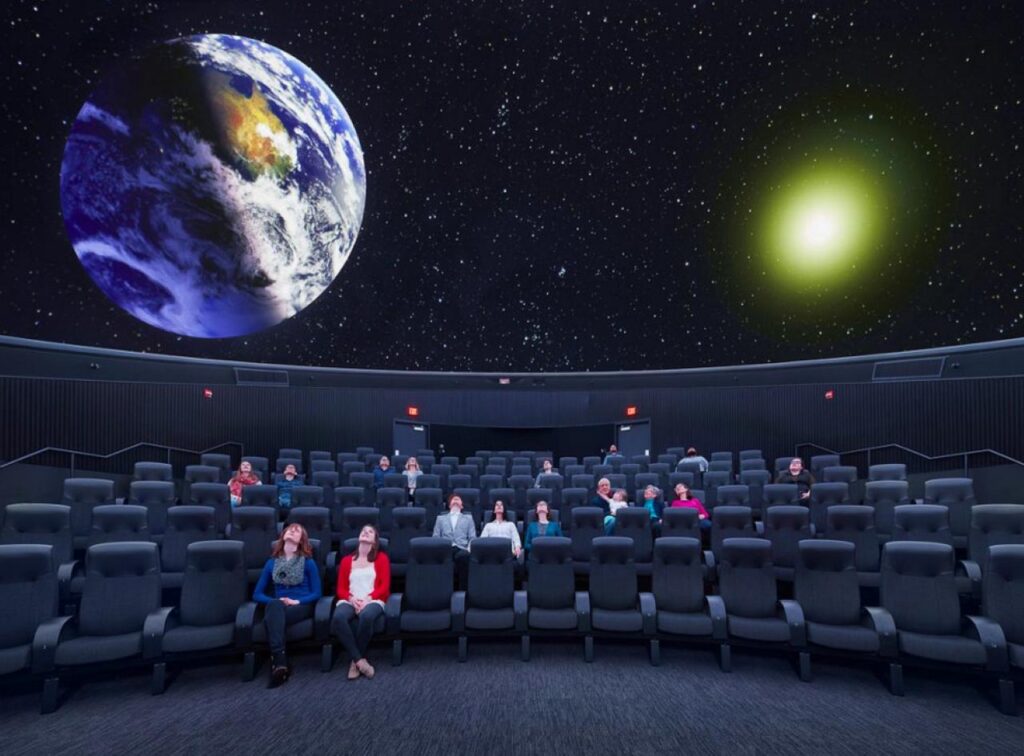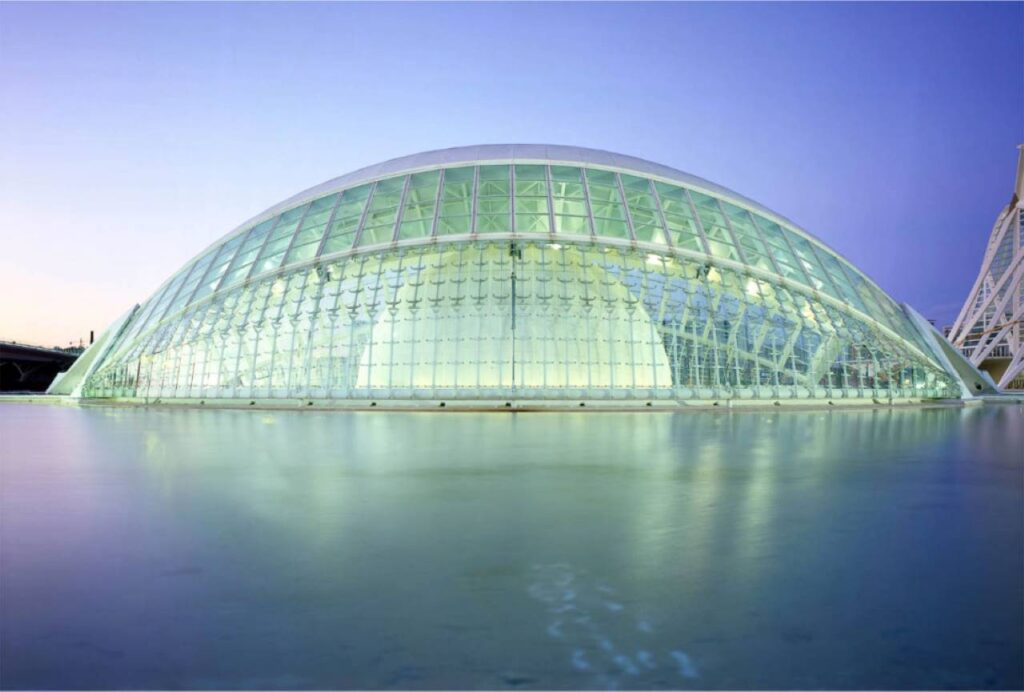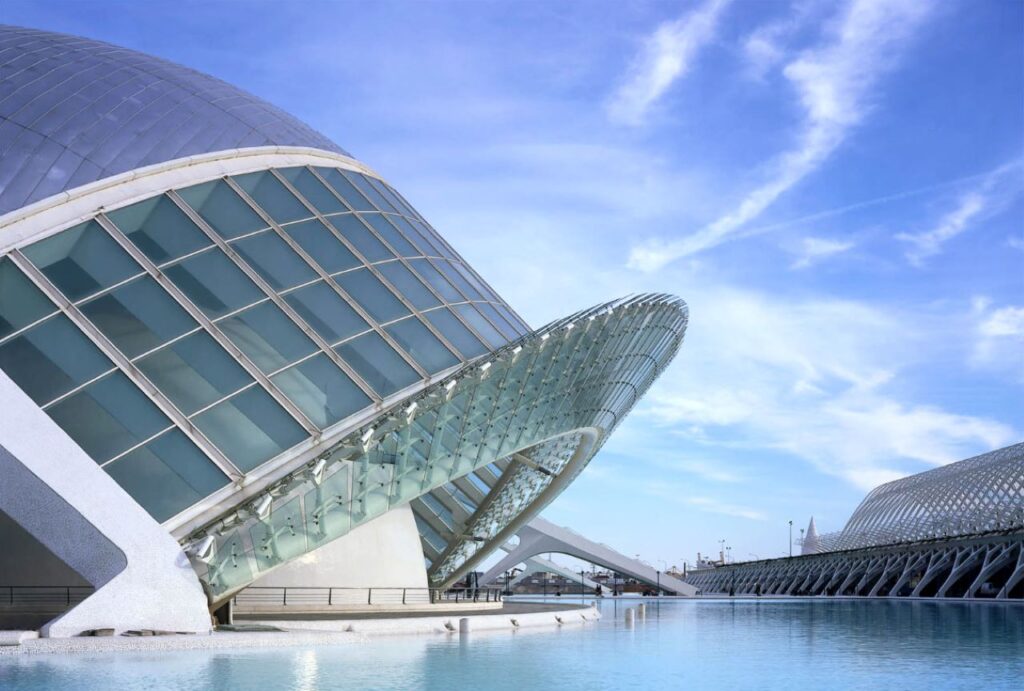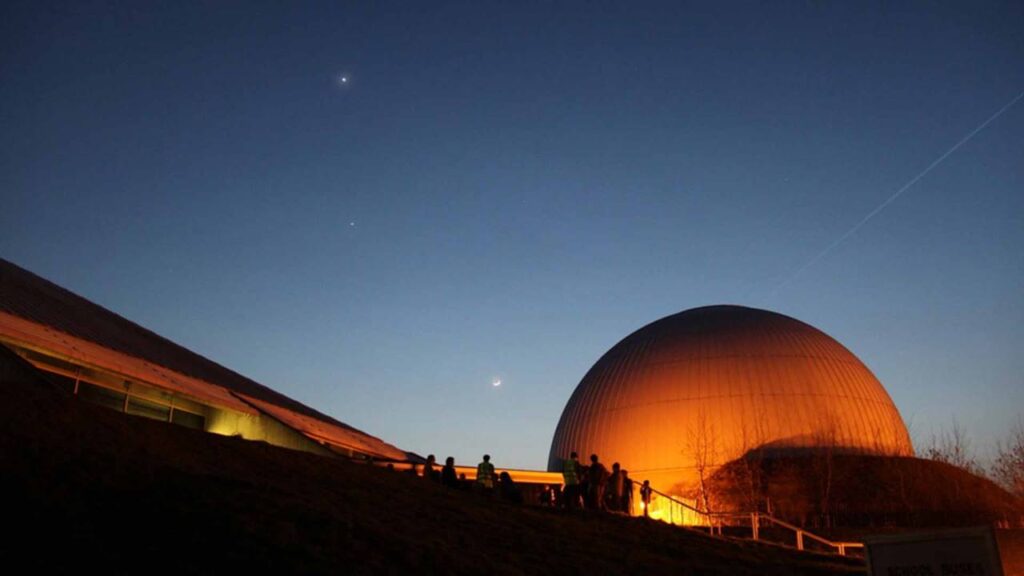Table of Contents
Overview
A planetarium is a structure dome-like, which offers a space where people can watch the night sky. The solar system, other celestial bodies, and constellations can be witnessed closely in planetariums. Some planetariums also have telescopes through which people can look into space.

Planetariums are the world’s cosmology study halls and theaters of open science instruction that have served maybe a billion people during the previous century. There are 3000 planetariums, including over 100 nations around the globe. Planetariums likewise were used to prepare early astronauts in heavenly route methods. By indicating the interesting revelations in cosmology and space investigation, planetariums are a significant device for expanding science education.
Challenges
According to the current scenario, planetariums are often monotonous in the design aspect. They have a room with a screen on which repetitive shows related to astronomy are displayed.
User Experience
Due to the lack of variations and real-time user experience, not a large crowd is attracted to these locations.
Educational Aspect
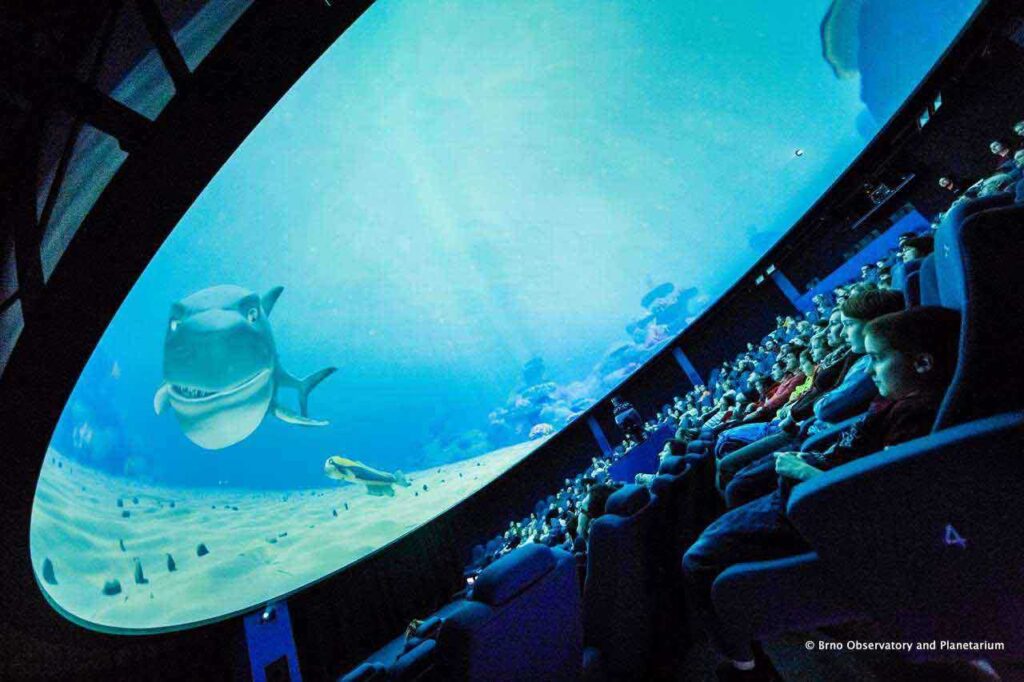
Educational aspect: Since the planetariums do not offer an appropriate learning environment, students cannot link the written educational data to the actual natural phenomena. They are not provided with opportunities to experiment and learn themselves.
Versatile Crowd
Few planetariums are based on universal design; therefore, visually impaired people, old or specially abled cannot visit them. Therefore, research needs to work upon alternative mediums through which specially abled can also enjoy and benefit from these astronomical spaces.
Pre-existing Standards
International Planetarium Society
Digital Domes
Digital domes permit the planetarian to explore the night sky with freedom, zooming in on deeper sky objects, visualizing the paths of celestial objects, and randomly switching to any period. Digital planetariums also operate as large format cinemas, showing astronomical simulations, archeoastronomy sites in three dimensions, and diversity of science and entertainment programming.
Some companies offer two types of screens for geodesic domes: tilted and non-tilted, based on the size and the purpose of the dome required. The laser modules are being made that will be used with a high-powered laser illuminated projector. The precise color of green, or red and blue, and their precise intensity can be accurately determined with its use. Now the IMAX will also be incorporated into planetariums for a better real-time experience of astronomical spaces.
Immersive Audio resources
This is used to create space between audio objects. The sound elements become more confused if more elements are jammed into two stereo channels. A side effect of this spatialization is that you can also place the sound in a spatial location in the room to simulate the location that can be heard in the real world. This is called “imaging”.
Portable/ Mobile Domes
The portable planetarium dome is made of high tensile strength fabric. They are opaque, light and non-crease. They are made of multiple layers of fabric and are suitable for projection in a full-dome digital planetarium. These mobile planetarium domes are suitable for indoor use. These domes will not be squashed, nor will they squirm. Access is via a 6-foot vertical zipper system.
The inner projection surface of ‘Digidome’ is gray, which is helpful for night sky projection. The portable dome is available in three different standard sizes and diameters, 5 meters 6 meters, and 7 meters.
Even if the entrance or exit is open indefinitely, these portable planetarium domes will not shrink or sag. This is important because it helps minimize the time between two consecutive performances.
Reference and sales materials in planetariums
Reference and sales material play an important part in the educational use of planetaria. A reference library for staff use is essential. For members and the public, a reference and lending library is desirable. Sales materials can represent an excellent selection of books, pamphlets, and star charts for persons who are interested in astronomy. A review of materials in a reference library at a planetarium includes books for all ages and levels of interest.
Indian Planetarian Society

It was established in 2000 by Dr. J.J. Rawal. The aim of the Indian Planetarian Society is to popularize Planetary Science, Solar Physics, Astrophysics, and unified subjects by arranging short courses, meetings, symposia, classes, and workshops for students, educators, specialists, and the public.
National Council of Science Museums
The National Council of Science Museum (NCSM) is an autonomous body under the Ministry of Culture of the Government of India. It was established on April 4, 1978. Today, it manages 25 science centers and museums in India.
Science City, Kolkata, Bella Museum of Industry and Technology (BITM), Kolkata, Nehru Science Center, Mumbai, Vishvesvraya Museum of Industry and Technology (VITM), Bangalore, and Delhi National Science Centre are national NCSM centers. At the regional level, there are regional centers called “satellite units” (SU).
Architectural requirements to meet the aim of planetarium
Planetarium buildings- design and construction
One of the key problems facing any institution considering a planetarium program is the most efficient use of space. In several recently constructed planetariums, the radius of the planetarium chamber is several feet greater than the radius of the dome. This provides a rather interesting cosmetic situation and, in several cases, has improved both the acoustics and the air conditioning situation. The other architectural feature that can affect the public intake of planetariums is its facade.
The common notion of people is that planetarium is an unpleasant structure. Therefore, if the facade of the planetarium building is worked upon and design interventions are done to create an aesthetic sense, a distinctive structure would be created. The people of the particular area would certainly be attracted to it. The structure would act as a city landmark.
Architectural problems in small planetariums
The small planetarium gains economic and educational advantages when they are attached to or built in a larger institution; the effectiveness of the planetarium instrument depends on the design of the room in which it is housed, and if plans and materials for this room were standardized, it would help new planetariums to secure the best use of the instrument. These studies of large and small planetariums show their common needs, regardless of size.
Innovative techniques for enhancement of user experience
Educational Aspect
Planetarium and secondary education
Elementary school science is now being recognized as a basic subject and not just a hobby. We all concur that to make younger students interested in space science, we have to make the subject intriguing and genuine to them by utilizing many visual guides and by related field trips. In the region of space science, kids can figure out how to watch, measure, draw, and record.
Cosmology is now a universe of imagination for young students. The issue is to keep his psyche supported with adequate, exact data so that in the wonder of the planetarium, his rich creative mind can work independently.
Planetarium and adult education
For however much a child may enjoy a synthetic experience, it denies him the opportunity to be personally creative. The average adult, on the contrary, whose imagination is atrophied and whose mind is clouded with worries and pains, needs to have his imagination stimulated before it can operate at all. In program planning, it is indicated that the child’s program needs to be led from the specific, astronomical idea toward the related areas.
The adult program needs to be directed from the related areas (philosophy, the arts, history, literature, etc.) toward the scientific. Of course, one advantage of a series of adult programs is the more academic approach available to the lecturer.
Experiential Learning
Children usually enjoy doing role plays and getting engaged in activities that are fun to do. Therefore, there can be activities introduced in planetariums that let children dress up like astronauts and pretend to go on a moon or say mars mission. This would let them experience a similar scenario and make them learn practical concepts easily through fun activities. Spaces for these activities can be created such that they replicate a similar environment at these satellites or planets.
Adults can be given chances to experiment with the science concepts to understand them. It must be clearly indicated that a person compulsorily need not have a physics background to understand astronomical spaces. Astronomy is an experience that can be understood over time through various activities. Even people who have a pretext of astronomy can also benefit from these activities, since the universe is infinite and there is always a lot to know about it.
Universal Design in Planetarium
Specially abled people are denied the privilege of participating in a unique educational experience because of their special problems. The installation of accessible exhibits, tactile explanations, hearing loops, step-free access, changing places, toilets, sensory rooms, and other accessibility guides are being included in recent developments of the planetarium.
Muscular dystrophy

In cases of muscular dystrophy or polio groups, there must be enough space in the planetarium to allow space for wheelchairs and special braces. The planetariums can also be designed with the provision of ramps. Roll-on roll-off lifts have been provided between the two floors of the exhibition in many planetariums for easy access.
Visually impaired
For the visually impaired and blind people, the advantages of sound systems can be taken. The L’Hemispheric planetarium at Valencia (Spain) has seven different speakers that are distributed over the 24m-diameter spheric screen lets the visitors identify the direction from which the sound is arriving. Each constellation and the special star has a specific sound associated with it.
Mentally retarded groups
While speaking to mentally retarded groups which occasionally visit the planetarium, a simplified presentation must be given to make the sky show easily comprehensible. If some knowledge of the intelligence level of the class is obtained beforehand, the talk can then be patterned according to the capabilities and interests of the particular group.
Presentation techniques and special effects
Sound effects in the planetarium
A good sound system can add tremendously to the effectiveness of planetarium programs, but there is room for discussion about the appropriateness of its use in certain areas. It is unnecessary to point out that music is a great mood-setter and can begin its work at the very beginning of a planetarium program. A few minutes of music before a program starts can make the waiting period more pleasant for the adults and seem to hold back the restlessness of the children.
Development and use of auxiliary devices in the planetarium
Auxiliary projection devices can contribute to a planetarian demonstration. Some devices may only lend a bit more drama to the performance, such as a sunrise or sunset, while others are as valuable as teaching aids, such as a projector model of Cepheid variable or the appearance of a nova.
Use of black light in the planetarium
Nowadays, it is used in crime investigation, advertising, and as an ornamental medium of many uses. The armed forces are using it extensively in their various training programs. As a visual teaching aid, it has many applications. In the museum and planetarium field, the importance of black light as a dramatic medium for astronomical spaces and different natural science exhibits has rarely been explored except by a few artists and technicians.
Fluorescent painting has been not used practically in the past; it has been just the use of pure colors which lack the sense of light and shade. Many expensive and huge mistakes have been made in using this medium because it has fallen into wrong hands. Most of the use has been experimentation and there is quite little data available on fluorescent painting. The “black light” produced when fluorescent pigments are exposed to ultraviolet radiation lends dramatic intensity and translucency to planetarium exhibits.
Public Engagement
Astronomy is often taken as a serious science topic by the public. The entertainment aspect of planetariums is usually ignored. They find it difficult to understand astronomical space concepts and thus do not seem attracted to them. If they are provided a platform where they can experiment, enjoy and learn science that too with the professional help of specialists in this field, the audience count would experience an escalation.
Therefore, mass gatherings must be organized that can either be in an enclosed area or under a natural sky where people of different age groups and categories would meet to have a soothing and fun experience of astronomical phenomena. This would further make people visit the planetariums to experience a detailed version of the universe.
Planetariums around the world that use innovative techniques and design interventions
Adler Planetarium, Chicago
Overview
This planetarium is constructed at the shore of Lake Michigan in Chicago, Illinois. It is one of the finest planetariums in the United States since it fulfills the basic parameter that is the user experience. It has attractive galleries that have been designed in such a way that it creates a surprise element and interests the visitors.
Accessibility
We can access the planetarium through public transit and personal vehicle.
Circulation
The circulation of this building is circular and radial, following the shape of a dome. The other spaces are quite complex, but signage makes it easier to navigate.
Construction materials
The building has a dodecagonal base structure of rainbow granite with a lead covering as the topping. The dome is made of perforated aluminum panels suspended from the ceiling and adjacent walls.
Lighting and colour
Natural lighting is the dominant source of lighting within the facility. Artificial lighting has been provided or special exhibits. Welcome Gallery space is lit with the use of backlighting and projection. Cool-toned colours that are connected with the universe have been used in the facility.
Services
The building is HVAC controlled. It has underground parking available for visitors.
Community Design lab
In this section of the planetarium, visitors can have hands-on experience and learn science concepts by experimenting. Various methods like drawing, painting, game activities, space missions are used to interpret or form an image of one’s own unique personal connection to the astronomical space.
Chicago Night sky Exhibitions
This feature of the planetarium uses digital interactive technology to create constellations in the sky. Lighting design is also experimented with in the planetarium to analyze better lighting.
Space Visualization Labs
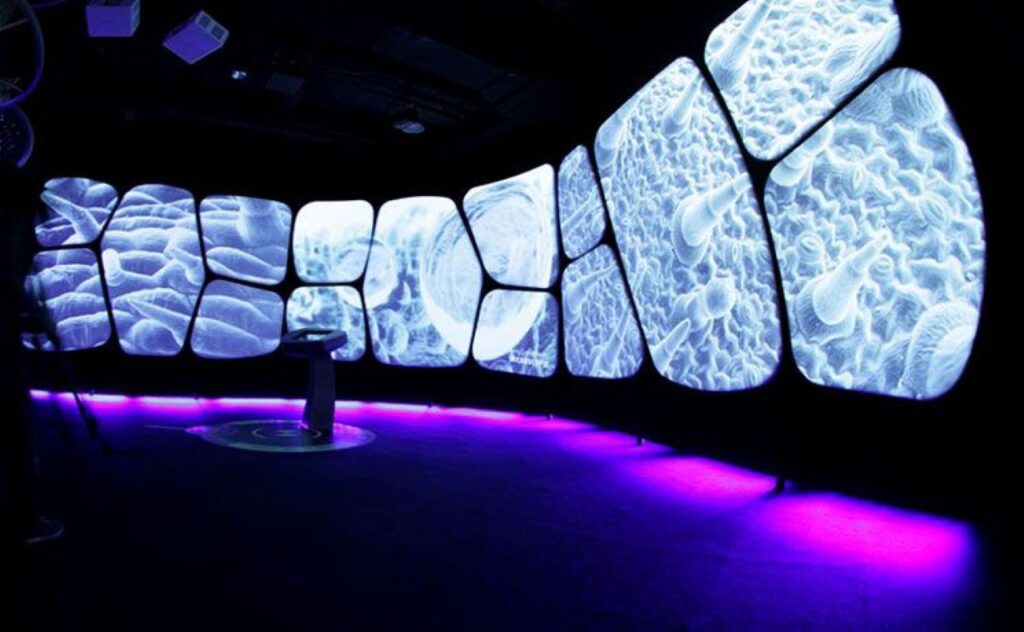
The space visualization lab (SVL) is a space of the planetarium where SVL assistants ensure the high-quality experience of the visitors by researching and making the projects of the planetarium accessible to people. Scientists, technicians, and educators work together in this laboratory to find new ways for people to explore the universe.
L’hemispheric Planetarium, Spain
Overview
The concept of the planetarium is based on an eye. It compares the wide range of wisdom that an eye sees to the wisdom and information that a planetarium offers. It has been designed in a way that the eye is seen closing and opening. There is also a pond around the eye-shaped building in which the reflection of the building is formed. This creates a mesmerizing view for the visitors, especially at night because of the application of light.
Accessibility
The planetarium building is well connected through bus and metro routes. The nearest metro station is 15 minutes away from the planetarium.
Façade and Landscaping
The landscaping of the planetarium has a water body in it which surrounds it. The entrance walkway is lit with the use of artificial lighting, which gives it a grand look.
Construction materials
The main construction materials are concrete and steel-framed glass curtain walls. The metallic covering comprises five arches supported by tripods. The arches are connected through laminated beams. The shutter built to represent the closing of the eye is made of expanded aluminum sheets that fold upward to form a roof that opens along the curved axis of the eye.
Lighting and colour
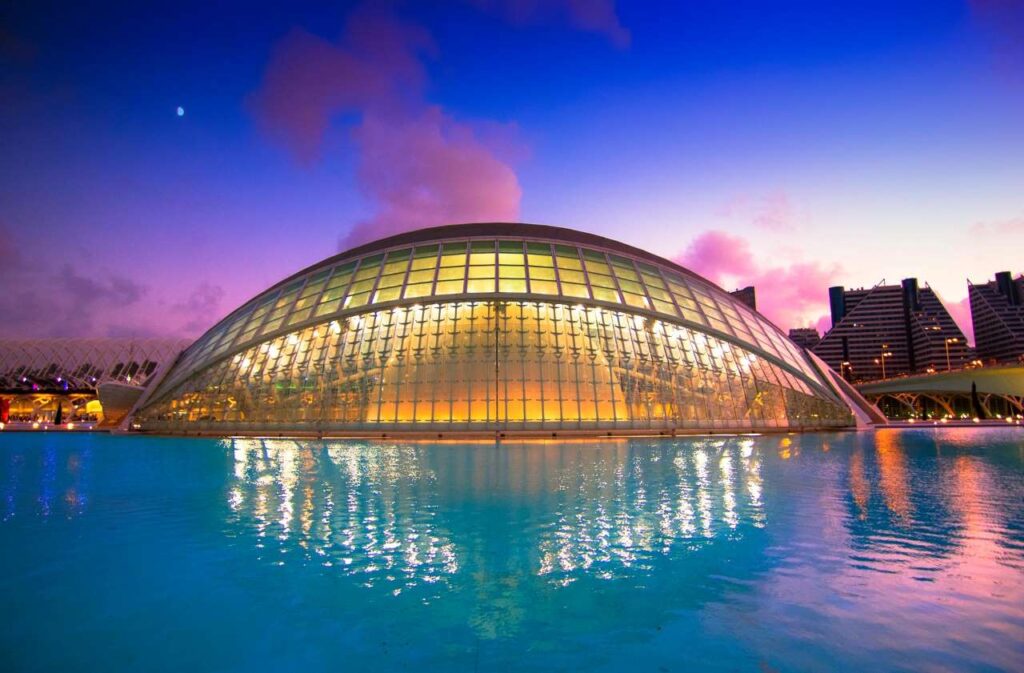
Natural lighting is the primary source of lighting because large windows and artificial lighting is used in spaces that do not have adequate lighting. White is the primary color throughout the facility. During the day, the water pond has reflections on it, and lights at the night project colours on the building.
Services
There is an underground parking facility provided. The planetarium campus also has a cafeteria where visitors can relax and eat. It has a shopping section where astronomical souvenirs are available for sale. The building is HVAC controlled.
Hayden Planetarium, New York
Overview
This planetarium is in the upper half of Rose Center for Earth and Space in New York, USA. The planetarium has a walkway that showcases the timeline of the Universe from the Big Bang to the present. At the bottom of the cosmic pathway, visitors can stop to look at exhibits of geology, weather in the Hall of Planet Earth.
Accessibility
The planetarium has well-defined public transit connectivity. Visitors can use the bus routes and trains to reach the planetarium.
Architectural details
The planetarium building has 5 floors. Planetarium spaces are on the first three floors and the other floor levels have archaeological exhibits. The ground floor of the building has parking on the lower level, which is accessed from the first floor. It has a food court, school lunchrooms and a shopping facility. There is a black hole theatre on this floor. The first floor has exhibits spaces for meteorites and a cosmic pathway. The second floor has the Hayden Big Bang theatre.
Universal design
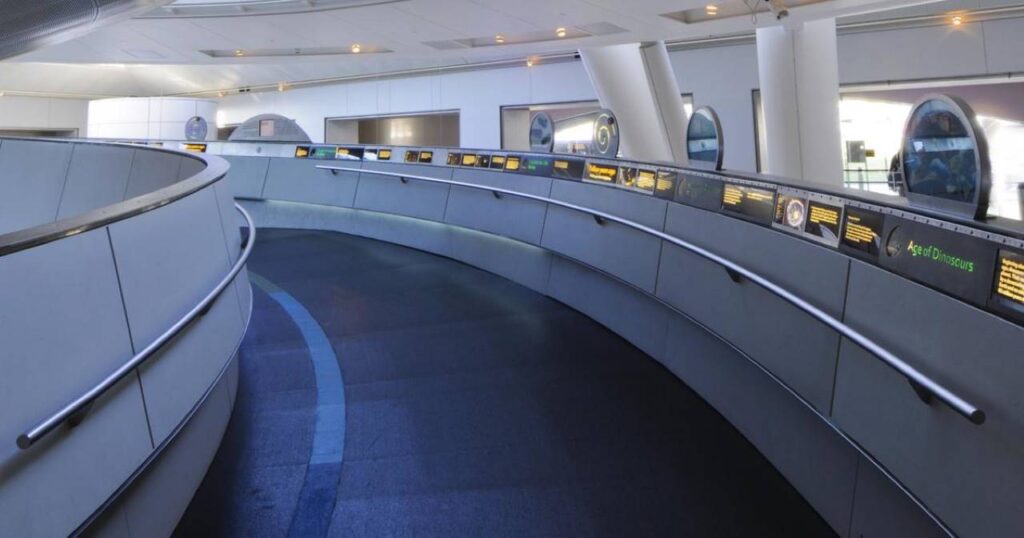
The planetarium is wheelchair accessible. It has ramps provided in the exhibit spaces that are accessible by variant people. The shows also have caption devices that help impaired people to experience the astronomical space. Show translations are available in various languages that make it accessible for people from different cultures. It is wheelchair accessible and has no obstructions, such as turnstiles or steps that would hinder any specially-abled person.
Social and Environment stability
The planetarium also has an open green space attached to it. This develops a sense of connection between the indoor and outdoor space. The green open space adds a contrast to the planetarium in a spatial context.
Winchester Planetarium
Overview
Winchester Science Centre is an accessible planetarium for all who believe in science. It focuses on STEM (Science, Technology, Engineering, and Maths) for young people and their families, especially those with disabilities and impairments. They are working to make the Science Centre and Planetarium accessible, inclusive, and a design for all buildings.
Invention Studio

The invention studio is open on weekends and school holidays for students and other people to come and explore science through experiments and science-themed challenges. These studios have different activities through which people can learn about astronomical phenomena, space missions, and other science concepts.
Universal Design
They have designed especially the shows for old-age people, keeping in mind their perspective and accessibility. Changing rooms are wheelchair accessible. Special tactile objects have helped blind people also feel the experience of astronomical space. The ‘After Dark’ events are designed for adults. The projection rooms have spaces dedicated to wheelchair users. Space is provided to accommodate wheelchairs if the users want to transfer on the seats.
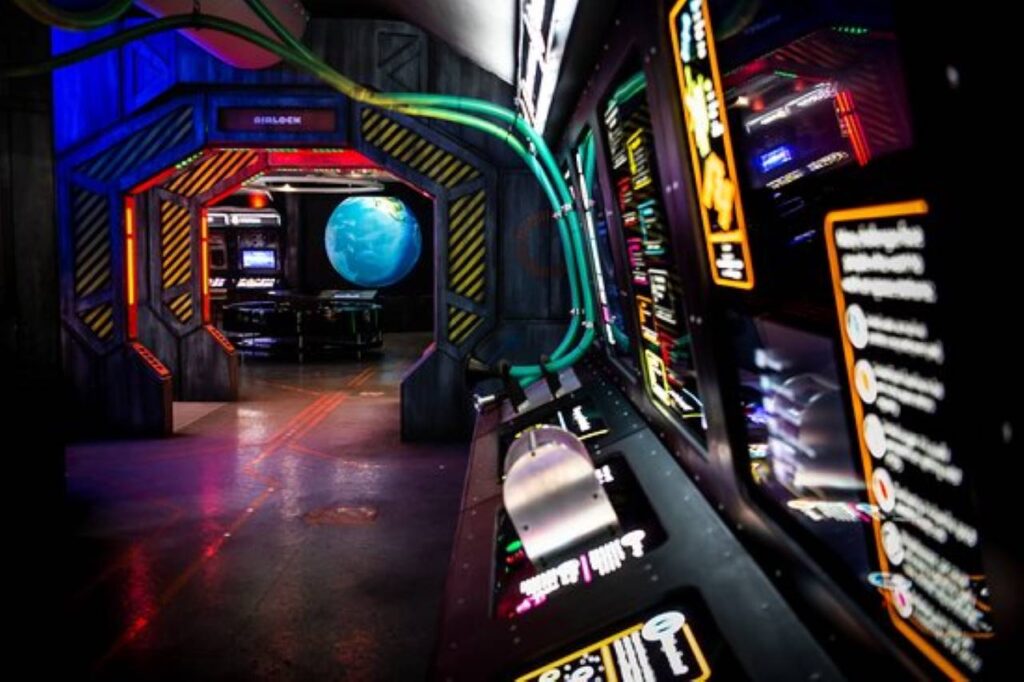
The planetarium also has quiet hour shows are dedicated to people who want to experience the astronomical phenomena in absolute silence. This show includes adjustments such as controlling lights, sound and swaying around the area, being able to sit wherever one likes. There are specific shows that are available with subtitles.
Birla Planetarium, Chennai
Overview
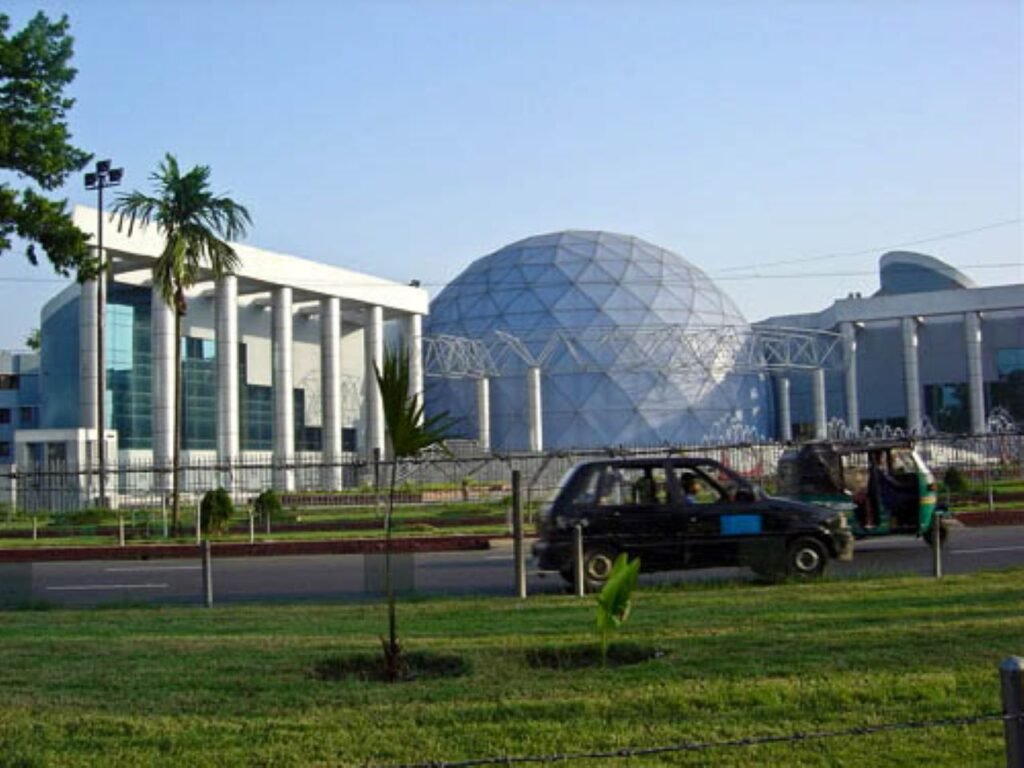
Birla Planetarium is in Chennai, India. It has 8 galleries, Physical Science, Electronics and Communication, Energy, Life Science, Innovation, Transport, International Dolls, and Children and Materials Science.
Accessibility
The railway station and bus stops are at a maximum of 2 kilometres from the planetarium.
Architectural Details
The planetarium has a hall of fame surrounding the major theatre and contains portraits, photos of scientists, celestial bodies, and space missions. The hemispherical inner dome of the planetarium is made from aluminium.
Technological aspect

The planetarium has a multifunctional optical-mechanical Starfield projector GOTO GM II, a special effects projector, and an XY table system for simulating various space phenomena. The GM II projector can perform annual, latitudinal, and precessional movements. A 6-segment multimedia projection system and 360-degree sky theatre were introduced.


